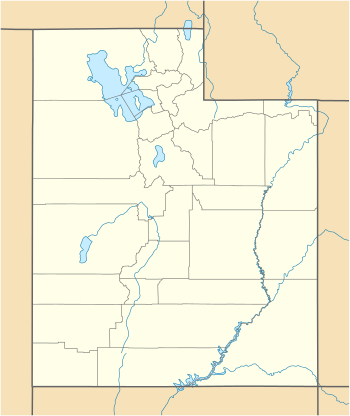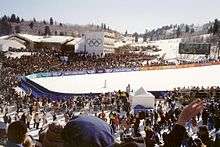Snowbasin
Snowbasin Resort is a ski resort in the western United States, located in Weber County, Utah, 33 miles (53 km) northeast of Salt Lake City, on the back side of the Wasatch Range.[1]
| Snowbasin Resort | |
|---|---|
 Late season in June 2005 | |
 Snowbasin Resort Location in Utah  Snowbasin Resort Snowbasin Resort (the United States) | |
| Location | Mount Ogden Weber County, Utah, U.S. |
| Nearest major city | Huntsville |
| Coordinates | 41.216°N 111.857°W |
| Vertical | 2,959 ft (902 m) |
| Top elevation | 9,350 ft (2,850 m) |
| Base elevation | 6,391 ft (1,948 m) |
| Skiable area | 3,000 acres (12.1 km2) |
| Runs | 104 |
| Longest run | Elk Ridge 2.9 mi (4.7 km) |
| Lift system | 11 Chairs: 9 - 1 tram - 2 gondolas - 3 high speed quads/six packs - 3 fixed-grip Surface: 2 - 1 Magic carpet - 1 surface tow (tubing hill) |
| Lift capacity | 14,650 skiers/hr |
| Terrain parks | 3 |
| Snowfall | 350 inches (890 cm) |
| Snowmaking | 600 acres (240 ha) |
| Night skiing | No |
| Website | www |
Opened 81 years ago in 1939,[1] as part of an effort by the city of Ogden to restore the Wheeler Creek watershed, it is one of the oldest continually operating ski resorts in the United States. One of the owners in the early days was Aaron Ross. Over the next fifty years Snowbasin grew, and after a large investment in lifts and snowmaking by owner Earl Holding, Snowbasin hosted the 2002 Winter Olympic alpine skiing races for downhill, combined, and super-G. The movie Frozen was filmed there in 2009.

Snowbasin is located on Mount Ogden at the west end of State Route 226, which is connected to I-84 and SR-39 via SR-167 (New Trappers Loop Road).
History
Snowbasin is one of the oldest continuously operating ski areas in the United States.[2] Following the end of World War I and the Great Depression numerous small ski resorts were developed in Utah's snow-packed mountains, and Weber County wanted one of their own. They decided to redevelop the area in and around Wheeler Basin, a deteriorated watershed area that had been overgrazed and subjected to aggressive timber-harvesting.[3]
Lands were restored and turned over to the U.S. Forest Service, and by 1938 the Forest Service and Alf Engen had committed to turning the area into a recreational site. In 1939 the first ski tow was built and in service at the new Snow Basin ski park.[3] In 1940, the Civilian Conservation Corps (CCC) crew built the first access road to the new resort, allowing easy access for the general public.[2]
In the 50's Sam Huntington, from Berthoud Pass. Colorado, purchased the ski area from the City of Ogden and proceeded to expand the up-hill capacity beyond the Wildcat single seat wooden tower lift and the old rope tow. Overall, Sam installed a twin chair in place of the rope tow, and a platter-pull tow, later replaced by a twin chair, was installed at Porcupine to the left of the steep rocky face of Mt Ogden.
In 1957 the NCAA Skiing Championships was held at Snowbasin and the downhill race course was set on the right side, of the steep face of Mt Ogden, on the slope called "John Paul Jones" named after an early Snowbasin skier. The John Paul Jones' run was only accessible if one engaged in a 45 minute hike from the top of the Porcupine lift.
Anderl Molterer, of the Austrian National Ski Team competing there that weekend, approached Sam Huntington and told him if a lift was built directly to the top of the John Paul Jones run he would bring his world famous Austrian National Ski Team to Snowbasin to train on it. Molterer said John Paul was the best downhill run in the world.
Huntington said no he had other things to do. A lift to the top of John Paul was not to be built until Snowbasin received the rights to hold the Olympic Alpine Downhill Ski Races in 2002
Sam Huntington was killed a few years later as he was replacing an electrical fuse at the Porcupine lift. Several Ogden businessmen purchased Snowbasin from the Huntington family.
One other major personality to come out of Snowbasin was M. Earl Miller who ran the Snowbasin Ski School from the mid 50's until 1987. Earl Miller played a key role in drafting the Professional Ski Instructors of America (PSIA) American Ski Technique in 1961.
Pete Seibert, founder of Vail, led a partnership which bought "Snow Basin" in 1978,[4][5] but ran into financial difficulty in 1984. The area was sold that October to Earl Holding, owner of Sun Valley in Idaho.[6][7][8]
2002 Winter Olympics & Paralympics
Because it was to serve as an Olympic venue site, the U.S. Congress passed the Snowbasin Land Exchange Act in 1996 as part of the Omnibus Lands Bill. The act transferred 1,377 acres (557 ha) of National Forest System lands near the resort to the private ownership of Snowbasin, and identified a set of projects that were necessary for the resort to host the Olympic events.[2]
During the 2002 games Snowbasin hosted the downhill, combined (downhill and slalom), and super-G events. The spectator viewing areas consisted of a stadium at the foot of the run, with two sections of snow terraces for standing along both sides of the run.[9] The spectator capacity was 22,500 per event; 99.1 percent of tickets were sold, and 124,373 spectators were able to view events at the Snowbasin Olympic venue.[10] During the 2002 Winter Paralympics, Snowbasin hosted the Alpine Skiing events, including downhill, super-G, slalom, and giant slalom.[11]
Statistics
Mountain information

at the 2002 Winter Olympics
Trails

- Total runs: 104
- Run ratings: 7 easier, 30 more difficult, 35 most difficult, 32 expert only
- Total Nordic trails: 5, approximately 16 miles (26 km)
- Nordic trail ratings: 3 easier, 1 more difficult, 1 most difficult
- Terrain parks: 3
- Terrain park ratings: The Crazy Kat (easier), Coyote (Intermediate), and Apex (Advanced) parks.
- Superpipe: none
Lifts
- Total lifts: 11[12]
- Chairlifts: 9
- 1 15-Person Tram made by Doppelmayr and installed in 1998
- Mt. Allen Tram
- 2 Gondolas high speed detachable, 8-person cabin configuration, made by Doppelmayr and installed in 1998
- Strawberry Express (Has a building built into the bottom station for cabin storage and a small cafe)
- Needles Express (Underground cabin parking at bottom station, is also shared with John Paul express)
- 1 High Speed Six (High speed detachable, made by Doppelmayr and installed in 2017)
- Wildcat Express (Replaced the 1973 Wildcat triple chair, manufactured by Thiokol)
- 2 High Speed Quads (High speed detachable, made by Doppelmayr)
- John Paul Express (1998) (Shares underground chair parking with Needles gondola cabins)
- Little Cat Express (Installed in 2008, replacing the 32-year-old Little Cat, which was a 1976 Thiokol Double)
- 3 Fixed Grip Triple chairs
- Middle Bowl (1979 CTEC Model with terminal shell upgrades by Doppelmayr in 1998)
- Becker (1985 Albertsson-Stadeli) (Loading belt added during the christmas of 2016)
- Porcupine (Porky) (1985 Albertsson-Stadeli)
- 1 15-Person Tram made by Doppelmayr and installed in 1998
- Surface lifts: 3
- 2 Magic carpet
- 1 Hand rope surface tow (tubing hill)
- Planned Lifts:
- Additional Lift for the Strawberry Bowl area, likely a H.S.Q. (High speed quad) - To allow for additional access into and out of Strawberry Bowl and to be able to operate when high winds prevent the Strawberry Express Gondola from operating
- Chairlifts: 9
Winter season
- Ski season dates: late-November to mid-April (conditions permitting)
- Operating hours: Gondola: 9:00 a.m. to 4:00 p.m. daily (some lifts close at 3:30 p.m. daily)
Grizzly Center Retail and Rentals: 8:00 a.m. to 5:00 p.m.
Summer season
- Summer season dates: Father's Day Weekend in June to First Weekend in October (conditions permitting)
- Operating hours: 9:00 a.m. to 5:00 p.m. Saturday, Sunday and holidays
- Total trails: 17, approximately 25 miles (40 km)
- Trail ratings: 4.5 easy, 6.5 moderate, 3 difficult, 3 hike only
References
- Grass, Ray (March 11, 1982). "SnowBasin". Deseret News. (Salt Lake City, Utah). p. D3.
- Snowbasin Resort Company (2010). "Our History". Snowbasin Resort website. Retrieved 30 November 2010.
- State of Utah. "History of Snowbasin". Utah History to Go. Retrieved 30 November 2010.
- "Vail founder buys resort". Spokane Daily Chronicle. Associated Press. October 21, 1978. p. 13.
- Knudson, Max B. (March 20, 1981). "Snow Basin hopes Trapper's Loop will let cat out of bag". Deseret News. p. D11.
- "Sun Valley Co. buys Snow Basin resort". Deseret News. October 11, 1984. p. 2B.
- Grass, Dan (January 24, 1985). "Snowbasin is finally headed in right direction". Deseret News. p. D3.
- Grass, Dan (September 11, 1986). "Snowbasin". Deseret News. p. D3.
- Salt Lake Organizing Committee (2001). Official Spectator Guide. p. 64.
- Salt Lake Organizing Committee (2002). Official Report of the XIX Olympic Winter Games (PDF). p. 75. ISBN 0-9717961-0-6. Retrieved 30 November 2010.
- Salt Lake Organizing Committee (2001). Official Spectator Guide. p. 186.
- Ski Utah (2010). "Snowbasin, A Sun Valley Resort". Ski Utah website. Retrieved 17 December 2010.
- Snowbasin Resort Company (2010). "Press Kit: Facts". Snowbasin Resort website. Retrieved 17 December 2010.
External links
| Wikimedia Commons has media related to Snowbasin. |
- Official website
- Ski Utah - Resort Profile
- First Tracks online magazine - Article on Snowbasin's 2002 improvements
- Future Plans as of 2014 - 2014 Article about expansion and upgrades to Snowbasin
